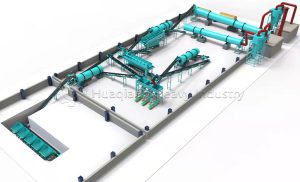Amid the wave of sustainable agriculture, organic fertilizer is undergoing a remarkable transformation. Once considered a nuisance, agricultural waste has been meticulously crafted through modern technology into a highly sought-after “black gold.” What are the secrets behind this remarkable transformation? Let’s uncover the mysteries of organic fertilizer production process.

Raw Material Pretreatment: A “Gorgeous Transformation” of Waste
Classified Collection: Organic waste such as livestock and poultry manure, crop straw, and food processing waste is strictly classified and collected.
Crushing and Mixing: A dedicated fertilizer crusher pulverizes large pieces of raw materials, such as straw, into 3-5 cm pieces and mixes them with livestock and poultry manure in a scientifically formulated ratio.
Fermentation Process: A “Feast” for Microorganisms
The mixed raw materials enter the fermentation process. Using a compost turning machine, the temperature, humidity, and oxygen content are precisely controlled to create an ideal “dining environment” for microorganisms.
Granulation: The “Shaping Moment” of Organic Fertilizer
Fermented organic fertilizer enters the granulation stage. The disc granulator uses a wet granulation process. Centrifugal force and a binder gradually form uniform granules from the moist organic fertilizer, like a snowball rolling larger and larger.
Drying and Cooling: Newly formed granules contain 15%-20% moisture and require slow dehydration in a fertilizer dryer at temperatures below 80°C. The subsequent cooling process brings the granules back to room temperature to prevent nutrient loss.
Screening and Coating: A vibrating screen separates qualified particles from fines. Some high-end products also undergo a biomass coating treatment, creating a slow-release effect, allowing nutrients to be gradually released as crops grow.
From a once-hated waste product to “black gold” that nourishes the soil, the production process of organic fertilizer embodies the true meaning of circular agriculture. When these particles are spread on the fields, they not only provide nutrients but also rebuild the soil ecosystem—this is the most valuable transformation in modern agriculture.


